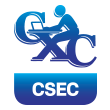Electronic testing, also referred to as computer-based testing, is a test conducted using a personal computer or an equivalent electronic device. This is the direction in which CXC is moving starting with the multiple choice papers in the January 2017 CSEC offerings.
Four of the major benefits of e-testing include:
1) Improved Quality
Electronic testing brings improved validity to the test forms candidates are given. The use of a variety of stimuli and response formats using different media adds to the authenticity of the tests. Thus allowing for more accurate judgement being made about the candidate’s competence.
2) It fits into candidates’ skill set
Today’s candidates are digital natives who know and live and breathe digital technology every day. E-testing therefore is a natural fit as it leverages the skills that they are developing on a daily basis. Candidates will be able to take advantage of their texting, typing, and keyboarding skills as well as their general tech savviness with e-testing. They use electronic devices regularly for social purposes. This is an opportunity to use those skills for educational purposes.
3) It enhances the possibilities for disabled candidates accessing the examinations.
E-testing makes testing more accessible to candidates with disabilities than paper-based testing. With the flexibility provided by the technology, screen readers can present text as synthesized speech, prints can be magnified, and use of graphics and videos enhances the authenticity of the test and provides for various ways of giving responses.
4) Candidates perform better
The research shows that candidates who use the electronic platform to take their tests perform better than those who take the same tests using pen and paper. There are many reasons attributed to this including reduction in transcription errors.
To learn more about this issue, please read this article in the British Journal of Education Technology: www.personal.psu.edu/faculty/r/b/rbc4/test_mode.doc
http://onlinelibrary.wiley.com/doi/10.1111/1467-8535.00294/full














This should hv been introduced before emarking. Nevertheless it’s a great and one of the best way forward
Students will receive results quicker … student can also review their response faster using this sysyem as compared to using paper-based selection …
Great move, but what about the cenews that don’t have adequate resources for candidates to sit the exams electronically?
That should be what about the exam centres that are without adequate resources for candidates to sit the exam online?
How is this going to be monitored?
Very good point
It seems like a natural progression nadia it’s in keeping with developed world. I may just concern about the facilities for testing. Do we have the infrastructure to support this type of testing across all schools in Jamaica?
This is a great idea.
While this is a grand idea..We are third world in resources in most schools..simple yfi connection do not exist in classrooms..As such more thought must be given to this process before its fruition as early as January 2017.
Will the schools be able to purchase the devices, one for each candidate, considering thei limited funds of many schools?
While I do agree that this in the right direction for authentic assessment,( I have major problems with how easy it is to purchase an SBA, since you can even decide the level of competence you wish to project) my caveat is – are all territories technologically ready for this change? Case in point in my country for 5 years form 1 students were given free laptops, a great idea! BUT, most students had no internet access at school, at many parents could not afford the internet charges,some schools had insufficent socket outlets, (some classrooms had no outlets, some of the older teachers were clueless. The male students downloaded porn and video games. Very rarely were they used as intended. Preparation and sensetisation is needed. Structures must be put in place. Yes the children know how to use a smartphone for social media and to download material and send selfies, however many are unaware of the resaerch potential and the real access it provides.
For other candidates resources play a major factor while E marking i too had to face many hurdles due to technology. Now since our focus is to important students access and opportunities for Education more consultations with schools and teachers needs to be done in order to find out their readiness.
For other candidates resources play a major factor while E marking i too had to face many hurdles due to technology. Now since our focus is to improve students access and opportunities for Education more consultations with schools and teachers needs to be done in order to find out their readiness.
Good idea Who will provide the computers?
Deslyn
Great idea.
How quickly will students be informed of there performance on this test?
I am still concern that the same teachers who have taught the students are asked to mark their SBAs. There have been on going suspicion about the validity of some grades.
I strongly believe that CXC is very inconsiderate, not all territories are ready for this initiative, atleast CXC should have given the participating countries adequate time to prepare!!!!!!!!!!!!, i think My territory Jamaica should withdraw from CXC and endorse other exams like GCE etc. its like CXC dont care at all, this monopoly thing is not healthy for the territories!!!, purely greed!!!!!!!!!!!!
What about older candidates and those who are not tech savvy? In addition, what about a number of territories where technology is not widespread and there are still numerous amount of people without computer access or little to no computer skills? Did CXC do the necessary consultation with the key players before deciding on such a drastic step so soon?
This is a huge step and while it might be in line with steps being taken in more progressive/developed countries, how many of the partnering territories can be deemed as progressive/developed hence being at a stage where such a move would not see a large number of would-be candidates excluded?
What about schools and institutes that are not equipped with the computer hardware? How about the candidates that are not techno savvy????
What are the profiles for earning a grade one in CSEC Principles of Accounts?
A letter profile is not a fixed mark. There is a range of marks for each letter profile and so two persons can have the same letter profiles but two different grades depending on which point on the scale their actual marks fall. It also depends on the weighting of each profile. In a particular subject one student got CCB grade II while another got CCA grade III. What this could mean is that the first student got marks at the high end of the profile while the second got marks at the lower end of the profile grades. In addition the first two profiles could be weighted heavier than the third profile.
Specifically, for POB, the weightings are as follows P1, 35%, P2, 40% and P3 25%. Clearly the first two profiles are weighted heavier than the last and therefore contribute more to the final grade. In this subject one student got ABB grade I, another got AAB grade II and another got CBC grade II. On the surface you would expect the second student to get the better final grade; however, the first student would have been at the high end of the marks for each profile while the second student would have been at the lower end of the marks for each profile and the third student at the upper end of the profile marks.